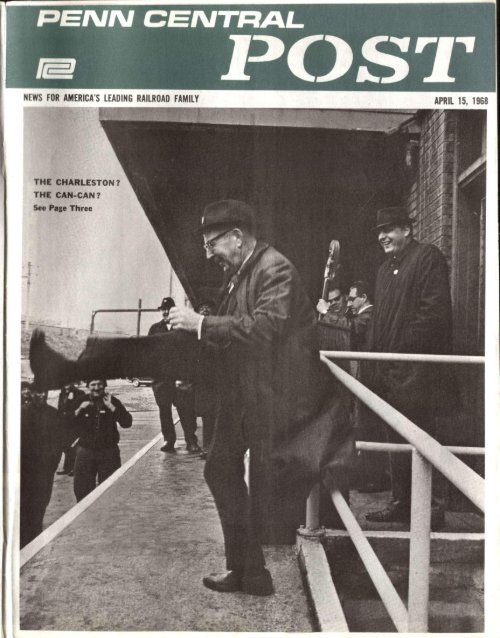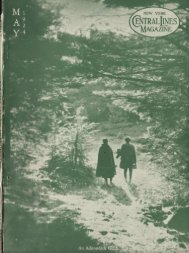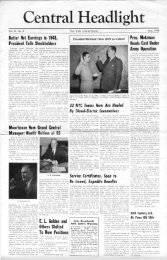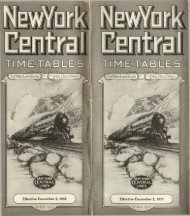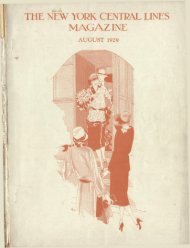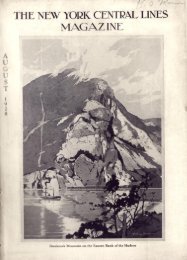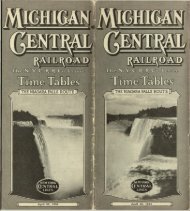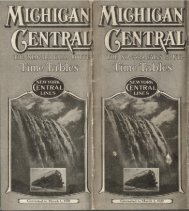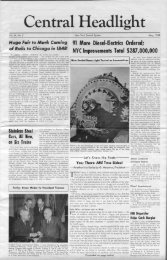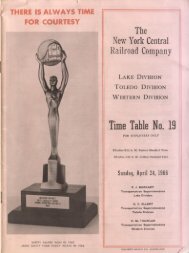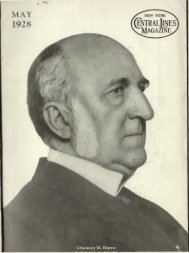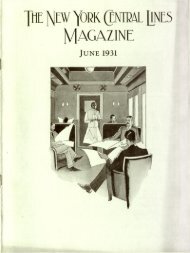central. post - Canada Southern Railway
central. post - Canada Southern Railway
central. post - Canada Southern Railway
You also want an ePaper? Increase the reach of your titles
YUMPU automatically turns print PDFs into web optimized ePapers that Google loves.
P»EA/A/ CENTRAL.<br />
POST<br />
NFWS FOR AMERICA'S LEADING RAILROAD FAMILY<br />
APRIL 15, 1968
They're brightening up<br />
the Empire Trains<br />
Joe Domogalik, Jr., is a Penn Central<br />
painter who works about 350<br />
miles from New York State.<br />
But Joe has a hand in determining<br />
the success of the Empire Service,<br />
which the Penn Central is providing<br />
for New York passengers.<br />
Electrician Gilbert E. Russell is<br />
involved, too. So is Sheet Metal<br />
Worker Wesley J. McLaurin. And so<br />
are scores of other employes who<br />
work in the former New York Central—now<br />
Penn Central—car shop at<br />
Beech Grove, Indiana.<br />
"We're fixing up the passenger<br />
cars so people will enjoy riding<br />
them," Joe Domogalik explains.<br />
"The Railroad will have a better<br />
chance of attracting passengers to<br />
this service if the equipment is<br />
bright and attractive.<br />
"That's our part of the job."<br />
They're fixing up coaches right down to<br />
the seat frames. General Foreman G. W.<br />
Sullas at Root Street Shop, Chicago,<br />
checks work of ^foreground) Alfred Jones,<br />
Peter Waskiewich and Joseph Pfeffer.<br />
Installing snack bar at Beech Grove, Ind.:<br />
W. J. McLaurin, sheet metal worker; W. E.<br />
Lashley, car repairman; Gilbert E. Russell<br />
and Topperwein Brickert, electricians.<br />
Empire Service was started by the<br />
New York Central last December<br />
and is being continued by the Penn<br />
Central. The service is an experiment.<br />
Its aim is to find out whether<br />
trains running on new, convenient<br />
schedules will lure travelers in New<br />
York State away from airlines and<br />
private automobiles.<br />
Eight trains run daily from New<br />
York City to Albany, one departing<br />
every two hours between 8: 30 A.M.<br />
and 10:30 P.M. Seven other trains<br />
depart every two hours southbound<br />
from Albany to New York City, between<br />
7:30 A.M. and 7:30 P.M., and<br />
an eighth at 4:30 A.M.<br />
Five of the runs in each direction<br />
also go between Albany and Buffalo.<br />
And two of the trains include sleeping<br />
car service between Buffalo and<br />
Chicago.<br />
Penn Central ads in New York<br />
State newspapers have called the<br />
public's attention to the convenient<br />
schedules and the advantages of a<br />
service that runs in weather that<br />
would ground airplanes. The motorist<br />
is reminded of the pleasures of<br />
relaxing instead of battling thruway<br />
traffic.<br />
The Empire equipment includes<br />
eight buffet bar cars, providing overthe-counter<br />
food and drinks.<br />
"People will want fast, convenient<br />
meal service, and they'll get it,"<br />
said Sheet Metal Worker Wesley Mc<br />
Laurin, who helped install the bar<br />
equipment at the Beech Grove shop.<br />
Topperwein Brickert, an electrician,<br />
said, "We've put heating and<br />
refrigeration units into these buffet<br />
bar cars, and they're compact and<br />
handy to operate."<br />
His fellow electrician, Gilbert E.<br />
Russell, said he expects passengers<br />
to respond favorably to the refurbished<br />
cars and the meal service.<br />
At another former New York<br />
Central shop—Root Street. Chicago<br />
—Penn Central men have been putting<br />
new covers on the coach seats<br />
for Empire Service.<br />
"I think they look very good," said<br />
Peter Maltese, tacking down a seat<br />
cover. "The bright color helps make<br />
a pleasant atmosphere for passengers."<br />
Louis J. Hencsel, an upholsterer<br />
gang leader with 42 years' service on<br />
the New York Central, added: "The<br />
seats are very comfortable to sit on.<br />
We did a sturdy job on them. They'll<br />
last a long time."<br />
"I understand he has a very low campaign budget.<br />
Refurbishing coach at Beech Grove, Ind: In foreground, Painters Richard D. Matzke<br />
and Joe Domogalik, Jr. Rear: Car Repairman Lashley, Electrician Topperwein Brickert.<br />
At Root Street Shop, Gang Leader L. J. Hencsel supervises seat renovation by Upholsterers<br />
H. M. Uppadine, Barney Stettner, Peter Maltese, L. T. Raczynski, S. Sobocinski.<br />
Refinished coach for Empire Service is given a final inspection at Chicago by General<br />
Foreman G. W. Sullas (since transferred to New York) and Supervisor Herman Fassl.<br />
John Kline is a member of the<br />
Armadillo Club.<br />
This is an exclusive club. To<br />
get in, there are two requirements:<br />
First, you have to get<br />
conked on the head. Second,<br />
you have to be wearing a safety<br />
hat at the time.<br />
Mr. Kline made the grade<br />
one day recently at the Lukens<br />
Steel Company plant in<br />
Coatesville, Pa.<br />
A Penn Central car inspector,<br />
Mr. Kline was visiting the<br />
plant to measure an excessive<br />
dimension load. He had just<br />
finished adjusting his leveling<br />
board when he was hit by a<br />
150-pound "plate dog."<br />
This heavy metal device,<br />
used to adjust the load, glanced<br />
off his hard hat and fell across<br />
his back. It had been accidentally<br />
pushed off the car by a<br />
nearby crane.<br />
"I was knocked out for a few<br />
minutes," Mr. Kline recalls,<br />
"but it would have been a lot<br />
more serious if I hadn't been<br />
wearing my hard hat. The<br />
Railroad gave me the hat and<br />
also my safety glasses. I always<br />
I want my hat../'<br />
wear both."<br />
Mr. Kline missed several<br />
days' work after the mishap,<br />
but that was because of bruises<br />
to his back.<br />
When he returned to work,<br />
the men at the Lukens plant<br />
made him a member of their<br />
Armadillo Club. He was the<br />
first railroader so honored at<br />
the plant.<br />
He was presented with a lapel<br />
pin, a gold-plated Armadillo,<br />
and an Armadillo decal for<br />
his hard hat. His membership<br />
papers include a citation for<br />
avoiding serious injury by observing<br />
sensible safety precautions.<br />
Mr. Kline is still wearing the<br />
same hat. It wasn't broken or<br />
dented.<br />
"I wouldn't give it up for<br />
anything," he said. "When I<br />
came to after the accident, the<br />
first thing I asked for was my<br />
hat.<br />
"The men kidded me about<br />
that, but I had them put it on<br />
the stretcher with me when I<br />
was carried out. I wouldn't be<br />
without it."<br />
1
They're in the Army now<br />
Eleven surplus Penn Central sleeping<br />
cars have been drafted into<br />
the Army.<br />
For a long time, the cars had been<br />
classified 4-F. Now a complete reconditioning<br />
job at the Passenger<br />
Car Shop in Altoona, Pa., is changing<br />
them to 1-A.<br />
They're due to serve in Army hospital<br />
trains.<br />
"We're going over these cars from<br />
top to bottom," explained Painter<br />
Ernest Grimminger. "It's not just a<br />
new paint job—it's everything."<br />
Car Builder Frank DiFolco was<br />
repairing the end of one of the cars.<br />
"We're cutting out all rusted and<br />
corroded spots and flush welding<br />
new plates for a smooth finish," he<br />
said.<br />
Pipefitter Joseph "Snowball" Fiochetta<br />
was reconditioning the car's<br />
air brakes. "They practically get a<br />
new system by the time we're finished,"<br />
he explained.<br />
The beds in the cars are being<br />
Painter G.H. Lechner puts finishing touch<br />
to reconditioned U.S. Army sleeping car.<br />
Car Builder Frank DiFolco replaces plate<br />
on sleeping car destined for Army service.<br />
I I I I I M I I I M I I M I I I I I I<br />
checked for smooth lowering and<br />
raising. All systems of the cars, such<br />
as electrical, steam and air conditioning,<br />
are being checked on the<br />
test track.<br />
Then the Tuscan red paint of the<br />
former PRR is covered with a shiny<br />
coat of olive green, the traditional<br />
color for U.S. Army vehicles. The<br />
roof is painted silver and a giant red<br />
cross is stenciled on.<br />
Finally the trucks are removed<br />
and are completely inspected. Any<br />
worn or broken parts are repaired.<br />
The sleeping cars are then given<br />
their "induction" inspection by Edward<br />
Hess, representative of the<br />
Army contracting officer.<br />
"They're old, but ideal for our service,"<br />
he says. "The Railroad is putting<br />
them in first-class working<br />
order.<br />
"They won't be on as rigorous a<br />
schedule for us as they were for the<br />
Railroad, so they'll last a long, long<br />
time. You could consider them<br />
brand new for our service."<br />
The cars are being assigned to the<br />
office of the Surgeon General. They<br />
will be put into ten Army hospital<br />
trains, to be used as sleeping quarters<br />
by medical personnel.<br />
These trains are being held in<br />
military bases on 24-hour call all<br />
year round, for use in event of national<br />
emergency. Each train is<br />
made up of a baggage car, six hospital<br />
unit cars, a kitchen car and a<br />
sleeping car.<br />
"The trains can be put into service<br />
in about the length of time it<br />
takes to get the railroad crews," Mr.<br />
Hess explains. "As an example of<br />
their use, four were moved into<br />
Florida during the Cuban missile<br />
crisis in 1962."<br />
The trains can be operated as<br />
complete units by crews from the<br />
nearest railroad or can move out in<br />
sections, attached to passenger<br />
trains.<br />
So it's a brand new career for the<br />
sleeping cars that once served on<br />
plush passenger trains. They're all<br />
GI now.<br />
Help for children of Vietnam<br />
To her son in Vietnam, a<br />
woman who works on the<br />
Penn Central wrote:<br />
"Is there anything I can send<br />
you?"<br />
Her son wrote back:<br />
"Thanks, but I don't need<br />
anything. The Vietnamese<br />
people, on the other hand,<br />
need much. Things that you<br />
use daily are unthinkable luxuries<br />
for them."<br />
Captain Paul R. Caldwell, a<br />
civil affairs officer in the Marine<br />
Corps, listed medical supplies,<br />
clothing and toys as most<br />
needed.<br />
So his mother, Mrs. Mildred<br />
Caldwell, a clerk with 15<br />
years' service on the New<br />
York Central, organized a collection.<br />
Employes in the capital expenditures<br />
division of the Penn<br />
Central Comptroller's Office at<br />
New York chipped in enough<br />
money to buy 30 pounds of<br />
bandages.<br />
This has been delivered to<br />
Hoa Khanh Children's Hospital,<br />
on the outskirts of Danang<br />
in South Vietnam. There are<br />
about 200 children there, suffering<br />
from injuries or disease.<br />
The hospital is supported entirely<br />
by contributions of Marines,<br />
Seabees and interested<br />
civilians.<br />
^IIIMMIMMMIIMMIIIMIMIIIMIIIIMMMMMIIMMIIMMMMMIMIMIMMIIMIIIIMIIMIIMIIIMMIMItMIIMMIIMIIMIMMIIMMIMIIMIIIMIIIIIIII<br />
2<br />
Clerk Mildred Caldwell displays<br />
the testimonial from the Marines.<br />
The letter from her son,<br />
which Mrs. Caldwell circulated<br />
among fellow employes,<br />
said:<br />
"The Viet Cong have some<br />
die-hard supporters, but for<br />
the most part this area is securely<br />
pro-government, pro-<br />
American. The V.C. are afraid<br />
of what we are doing over here<br />
and will stop us any way they<br />
can—including the killing and<br />
maiming of innocent people.<br />
When the Viet Cong rule, it is<br />
by fear and terror—not 'love'<br />
and 'flowers.' "<br />
Captain Caldwell asked for<br />
new or used clothing for dis-<br />
Painter Ernest Grimminger puts Army identification decal on renovated sleeping car.<br />
Reconditioned truck is spotted by Car Builder A. Johnson and F. Gunsallus, derrick hooker.<br />
Army Inspector Edward Hess and R. Schall,<br />
ass't foreman, inspect bunks in sleeper.<br />
tribution to children and<br />
adults. He mentioned plain<br />
colored pajamas for men; simple<br />
long-sleeve blouses, without<br />
designs, for women; any<br />
type of light clothing for children.<br />
He also suggested unbreakable<br />
plastic toys and<br />
squeeze dolls and animals.<br />
Mrs. Caldwell said money<br />
gifts may be mailed to her at<br />
the Comptroller's Office, Penn<br />
Central, Room 230, 466 Lexington<br />
Ave., New York, NY.<br />
10017.<br />
Packages should be sent to<br />
Commanding General (Attention:<br />
G-5), FLC 1st FSR, FPO<br />
Car Builder John Turcovski and helpers fix<br />
shock absorber on U.S. Army sleeping car.<br />
San Francisco, Calif. 96602.<br />
The generosity of Mrs. Caldwell<br />
and her fellow employes<br />
brought a letter of thanks from<br />
Brigadier General Harry C.<br />
Olson, of the Force Logistic<br />
Command in Vietnam. He also<br />
sent a Certificate of Appreciation<br />
to the Penn Central people.<br />
It said:<br />
"Your contribution to the<br />
United States Marine Corps<br />
Civic Action Program in the<br />
Republic of Vietnam is received<br />
with sincere appreciation<br />
as another step in the<br />
establishment of a nation dedicated<br />
to the cause of freedom."<br />
Penn Central people aided these children. Man at right is Capt. Caldwell.<br />
IMIIIMIIMIIIMMIIIIIIMIMIMIIMIMIMMIIIIIIIIIIIIIIIMIIIIIIIIMIIMIIIIIIIMIIIIIIIIMIIIM Illlll III! I III 1111 III! •Illllltlll II lllllllll IIIIIIIIIIIIIMII III 11III III lllllll 1111IIIMIMI III 1111 III IMIII1111IJI1IIIIIIIII11IIIIIIMIII1111 III lllllll III) III IMIMlll 11IMIIIIII III I III IMIIIIIIIMIIMIMIIIII III IMl.~
John McMurrough couldn't restrain<br />
himself.<br />
When the Irish Setters, a 3-piece<br />
combo of Penn Central employes,<br />
Car Repairman John Herman hands out<br />
buttons that brag about the safety record.<br />
At his left is Repairman Vince Carchidi.<br />
Why McMurrough did an Irish jig<br />
5^<br />
Meet the Irish Setters: Coach Cleaner Jim<br />
Louis, sax; Coach Cleaner Robert Whitley,<br />
banjo; Upholsterer Jim Gambale, bass.<br />
Retired ...<br />
Who. Me?<br />
gave out with a toe-tickling Irish jig,<br />
Mr. McMurrough gave a high-stepping<br />
response.<br />
It was all in the spirit of the occasion.<br />
The employes at Penn Coach Yard<br />
in Philadelphia were celebrating a<br />
record of 1,000,000 man-hours of<br />
work without a single reportable<br />
injury.<br />
(An injury is reportable if it disables<br />
an employe from performing<br />
his regular duties for as much as 24<br />
hours.)<br />
"A gr-r-reat r-r-record," said Mr.<br />
McMurrough, passenger car foreman,<br />
who came to America from<br />
Dublin, Ireland, 39 years ago, and<br />
has never quite learned to control<br />
his r's.<br />
He treated the maintenance-ofequipment<br />
employes of Penn Coach<br />
Yard, 30th Street Station and Penn<br />
Center Station, Philadelphia, to a<br />
coffee-and-cake shindig. A new flag<br />
in Penn Central green was sewn for<br />
the occasion and raised atop a flag<strong>post</strong><br />
to proclaim the safety record.<br />
Mr. McMurrough said the achievement<br />
was the result of good employemanagement<br />
relations and enthusiastic<br />
cooperation among the car repairmen,<br />
car inspectors, electricians,<br />
pipefitters, machinists, upholsterers,<br />
coach cleaners and others who keep<br />
the commuter car fleet going.<br />
These employes have a respectful<br />
knowledge of the little brown book<br />
of safety rules, he said.<br />
Car Repairman Dominic L. Massaro<br />
pointed out that his gang holds<br />
a brief safety session every day before<br />
work starts, and each time a<br />
man, chosen in rotation, reads out a<br />
safety rule. This is discussed to make<br />
sure everybody knows how the rule<br />
applies to his particular job.<br />
Larry Simpson, a machinist,<br />
said, "Safety goggles are the most<br />
important thing when you're working<br />
metal-to-metal. You never know<br />
when something might fly off and hit<br />
T3etirement appears to be just<br />
a word to Herbert C. Mix,<br />
Sr., former block operator at<br />
Port Allegany, Pa., on the<br />
Northern Division.<br />
Since leaving the Railroad,<br />
Mr. Mix has devoted himself<br />
full time to being mayor in Mt.<br />
Jewett, Pa.; Grand High Priest<br />
of the Grand Encampment of<br />
Pennsylvania, Independent Order<br />
of Odd Fellows; and governor<br />
of District 14F, Lions International.<br />
Because of this last <strong>post</strong> he<br />
also is a member of the Pennsylvania<br />
Council of Lions<br />
Clubs. The council is made up<br />
of the 16 district governors in<br />
the state and sets policy for all<br />
Lions Clubs.<br />
you in the eye. Goggles could save<br />
your sight."<br />
Albert S. Yonan said that as an<br />
electrician, he has to be alert to the<br />
special hazards of electric current.<br />
"I always disconnect the power<br />
source before working on an electrical<br />
circuit," he said. "It's unthinkable<br />
not to. And in handling any<br />
kind of wire, I wear gloves to keep<br />
from getting cut or bruised."<br />
Car Repairman Massaro said he<br />
puts special emphasis on properly<br />
placing wooden blocks when using a<br />
jack to lift a car.<br />
"You've also got to be sure the<br />
jack gets periodic inspection," he<br />
added. "You can't be too careful—<br />
not when your life is involved."<br />
Walter A. Thomas, Jr., a gang<br />
foreman, stressed that when men<br />
work on track, they make sure to<br />
put up blue warning flags and see to<br />
it that the switches are blocked to<br />
prevent an unexpected movement<br />
of the cars.<br />
"Talk to any of my men—they'll<br />
tell you the precautions they take in<br />
their jobs and how proud they are to<br />
have a shop with no accidents," he<br />
said.<br />
"Keeping the place clean is very<br />
important," contributed Laborer<br />
Walter H. Bowers.<br />
"As long as you pick up after<br />
yourself, there won't be anything to<br />
trip on. Also, keep your clothes clean<br />
and free of grease, especially if you<br />
work with fuels.<br />
"I ought to know. A man who has<br />
worked 47 years without an accident<br />
has to be doing something right."<br />
Having reached 1,000,000 manhours<br />
without a reportable accident,<br />
Mr. McMurrough's people have naturally<br />
set their sights on 2,000,000<br />
man-hours.<br />
"We feel we can make it," said<br />
Walter McFadden, assistant foreman.<br />
"You see, there's no daydreaming<br />
here—if something is a hazard, it's<br />
corrected on the spot whenever possible.<br />
"You can't take chances with your<br />
life or your fellow workers'.<br />
"And we don't."<br />
Carman Joe Bosselli and Assistant Foreman Joe Burns help Mr. McMurrough raise the flag.<br />
He'll travel about 54,000<br />
miles as governor of the sevencounty<br />
district in the northwestern<br />
section of the state and<br />
as council member for the<br />
Lions and Grand High Priest<br />
for the IOOF.<br />
He expects that latter <strong>post</strong> to<br />
give way to that of Grand Patriarch,<br />
the highest office of the<br />
order in Pennsylvania. That<br />
term should start in October,<br />
1968, and continue one year.<br />
Mt. Jewett is Mr. Mix's home<br />
town. He has been active there<br />
in local government for 25<br />
years—first as a councilman<br />
and then as council chairman, a<br />
<strong>post</strong> to which his fellow councilmen<br />
elected him for eight<br />
consecutive two-year terms.<br />
"I don't know if I'll run again<br />
when my term expires," he<br />
said. "But I'll be around some<br />
place. I enjoy serving people<br />
and feel that those who don't<br />
help others are missing something."<br />
He explained that after his<br />
offices run out, he and his wife,<br />
Esther, would do some personal<br />
traveling, and visit their sons,<br />
grandchildren and great grandchildren<br />
more often.<br />
Mr. Mix worked with the<br />
Railroad 44 years. He spent<br />
over 24 years as a block operator<br />
at Port Allegany.<br />
"I enjoyed my time on the<br />
Railroad," he said. "It was a<br />
wonderful experience. But I'm<br />
enjoying retirement, too."<br />
3
When the job is a tough one<br />
CALL US . . .<br />
A. L. Rineman, Penn Central car inspector,<br />
measures load to make sure of clearance.<br />
Car Inspector F. H. Hockenbury puts oil<br />
in the journal box of a heavy-duty car.<br />
4<br />
PENN CENTRAL<br />
It was due to move only 2% miles<br />
on the Penn Central, but it was<br />
one whale of a load.<br />
It was 190 feet, 2 and % inches<br />
long; 13 feet, 10 inches wide; and 17<br />
feet, 9 inches high.<br />
"Biggest thing we've ever moved<br />
around here," was the awed comment<br />
of Yardmaster Walter Chmiola<br />
at Buttonwood Yard, Wilkes-<br />
Barre, Pa.<br />
Actually, it was precisely 7 and %<br />
inches short of matching the longest<br />
single load ever hauled on the PRR<br />
or the Central—a Bethlehem Steel<br />
girder that was shipped in 1960.<br />
This new load was a heat-exchanger,<br />
used in oil refining. It was<br />
built at Air Products and Chemical<br />
Company, at Wilkes-Barre. Penn<br />
Central people gave it super-careful<br />
handling over the route to the interchange<br />
point where the Lehigh Valley<br />
Railroad took over.<br />
The shipment's ultimate destination<br />
was an Esso Standard refinery<br />
in Libya, North Africa.<br />
The load was cradled on three<br />
flatcars and overhung an idler car<br />
on either end—five cars in all<br />
Engineman William Paige's orders<br />
were precise: Speed not to exceed<br />
five miles per hour.<br />
To make sure nothing happened<br />
to this extremely valuable shipment,<br />
six officials walked ahead<br />
Conductor W. G. Nelson and Brakeman<br />
R. G. Kline get set to move the load out.<br />
First aid ... fast!<br />
1%/Tariano Bonasera is doing<br />
-L'A fine now. After an apparent<br />
heart attack, this New York<br />
Region brakeman is rapidly recovering.<br />
A lot of the credit goes to<br />
fellow employes at Sunnyside<br />
Yard, the big passenger-train<br />
terminal on Long Island, across<br />
the river from Manhattan.<br />
It happened on a cold, snowy<br />
night. Conductor Bonasera,<br />
who works on a yard shifter,<br />
suddenly collapsed with heart<br />
Harry Walker, baggage foreman<br />
was quick to give supportive first aid.<br />
pains.<br />
Harry Walker, baggage foreman,<br />
immediately began giving<br />
supportive first aid. Conductor<br />
Fred Doerge phoned<br />
the trainmaster to send for an<br />
ambulance. The shifter crew<br />
put Mr. Bonasera aboard the<br />
engine and carried him to the<br />
yard office.<br />
Electrician Foreman F. Szambel's<br />
station wagon served as ambulance.<br />
Railroad officials walked the load the whole 2'/2-mile trip to take care of any difficulty.<br />
of and beside the train all the way<br />
to the interchange. Ready to take<br />
care of any emergency or unforeseen<br />
problem were R. J. Rushmore,<br />
acting trainmaster; R. F. Piontek,<br />
motive power foreman; D. R. Wolfe,<br />
district engineer; R. J. Wagner,<br />
sales representative; R. L. Milhollen,<br />
freight agent; and E. O. Mc-<br />
Guire, supervisor of loading service.<br />
Nothing unexpected occurred. One<br />
clearance problem was a flasher signal<br />
pole at a highway crossing. The<br />
Signal Maintainer L. T. Faust had to take<br />
out a flasher signal to make more room.<br />
Frank Szambel, electrician<br />
foreman, stood by with his station<br />
wagon. And when it became<br />
evident that the ambulance<br />
couldn't make it to the<br />
yard because of slippery roads,<br />
Foreman Szambel drove Mr.<br />
Bonasera to the hospital,<br />
where he was immediately put<br />
in the intensive care unit.<br />
The prompt, intelligent action<br />
helped Mr. Bonasera improve<br />
rapidly, and soon he was<br />
discharged for at-home convalescence.<br />
"Seems as if practically everybody<br />
in the yard is first-aid<br />
conscious," said Frank L. Paulin,<br />
Sunnyside trainmaster.<br />
"There's a lot of interest in this<br />
subject and an awareness that<br />
the right thing, done at the<br />
right time, can save pain and<br />
disability—even save a life."<br />
Frank W. Frandsen, chairman<br />
of the Sunnyside Yard<br />
District Safety Committee, recalled<br />
the time two women car<br />
cleaners were overcome by<br />
smoke in a dining car.<br />
"Several men ran in and carried<br />
the women outside, while<br />
others gave first aid," Mr.<br />
Frandsen said. "This quick action<br />
enabled the women to return<br />
to work that same day."<br />
load would have bumped against it.<br />
Signal Maintainer L. T. Faust removed<br />
the signal pole just before<br />
the special train arrived, then put it<br />
back when the train passed.<br />
"It's the widest thing that ever<br />
came through here," said Mr. Faust.<br />
After safe delivery to the Lehigh<br />
Valley, Penn Central people congratulated<br />
each other.<br />
They looked forward to handling<br />
five similar loads scheduled to be<br />
shipped by the same manufacturer.<br />
After the load went through, without any<br />
trouble, Mr. Faust put the signal back in.<br />
Edward D. Laird, master<br />
mechanic, is encouraging the<br />
safety committee to obtain<br />
first-aid equipment, Mr. Frandsen<br />
added.<br />
"He wants us to develop our<br />
knowledge and skill to a point<br />
where we're ready for any<br />
emergency," Mr. Frandsen<br />
said. "And that's our goal."<br />
Recuperating at home, here is Mariano<br />
Bonasera with the family pet.
The merger at Jeffersonville-Former New<br />
York Central people and former PRR people are working<br />
together now at Jeffersonville, Ind.<br />
Freight operations in the area have been consolidated<br />
at the former PRR yard, which has a capacity of 1000<br />
freight cars. The smaller NYC yard, with a 400 car capacity,<br />
will be maintained primarily to serve local industry.<br />
This yard will also continue to be the Flex-Flo<br />
Terminal, equipped to transfer bulk commodities from<br />
railroad cars to trucks.<br />
Another NYC operation, involving Flexi-Van containers<br />
moving on flatcars, will be transferred to the PRR<br />
yard and consolidated with the TrucTrain terminal, which<br />
handles wheeled trailers on flatcars.<br />
The old Louisville and Jeffersonville railroad bridge,<br />
formerly used by the Central, won't be used any more.<br />
All train movements will be shifted to the PRR bridge<br />
spanning the Ohio River between Louisville, Kentucky,<br />
and Clarksville, Ohio.<br />
The yard consolidation, said Alfred E. Perlman, Penn<br />
Central president, will result in more efficient interchange<br />
of freight traffic between Penn Central and other rail<br />
lines serving the area.<br />
Passenger trains will continue to use the Union Station<br />
in Louisville.<br />
More CarS On the Way— Penn Central has announced<br />
an order for 2750 new heavy-duty gondola cars,<br />
the first major acquisition of equipment since the merger.<br />
"All the cars are to be built at our modern Samuel<br />
Rea Shop in Hollidaysburg, Pa., the largest railroad carbuilding<br />
shop in the world," said Penn Central President<br />
Alfred E. Perlman.<br />
In the order are 2150 gondolas of 100-ton capacity and<br />
52-foot length, and 600 of 70-ton capacity and 65-foot<br />
length for hauling extra-long steel beams and manufactured<br />
articles.<br />
Deliveries have already begun and will be completed<br />
in July.<br />
"This fleet of new cars, which would make a train<br />
more than 30 miles long, is a major step in our program<br />
to provide the most modern transportation service for<br />
our BHotomogs throughout tha grog wo »ow>," Mr. Pol—<br />
man said.<br />
Why railroads seek rate boost-in evidence<br />
filed with the Interstate Commerce Commission, the<br />
railroads of America have stated that they urgently need<br />
increases in freight rates to enable them to meet their increased<br />
costs.<br />
According to figures from 25 major lines which handle<br />
almost 85 percent of all railroad freight traffic, the<br />
net railway operating income last year was almost the<br />
lowest since the end of World War II. And the estimated<br />
figure for 1968, without a new increase in freight rates,<br />
would be scarcely higher than in 1967.<br />
Burton N. Behling, the AAR vice president for economics<br />
and finance, told the Commission that the railroad<br />
industry's net working capital at the end of 1967<br />
was at the lowest level in more than 20 years.<br />
The railroads calculate that in the last half of 1968,<br />
their wages and fringe benefits and other costs of operation<br />
will show an increase, on an annual basis, of $445,-<br />
000,000, Mr. Behling reported.<br />
Bridge Safety—Every bridge on every major railroad<br />
in the United States gets a complete inspection at<br />
least once a year.<br />
That was reported by railroad experts last month to<br />
the White House Task Force on Bridge Safety, appointed<br />
by President Johnson following the collapse of an Ohio<br />
highway bridge.<br />
Railroad safety practices were reviewed by a Railroad<br />
Bridge Safety Committee, consisting of 11 experts, including<br />
the Penn Central's John F. Piper.<br />
The Railroad is fined—A $1500 penalty was assessed<br />
against Penn Central by the New York State<br />
Commissioner of Health, because oil from railroad operations<br />
was alleged to be seeping into Buffalo Creek.<br />
The hearing officer, Earl W. Murray, said there were<br />
mitigating circumstances, in that Penn Central had made<br />
"attempts to reduce its oil discharge."<br />
The Railroad was given until May 15 to complete measures<br />
for halting oil seepage.<br />
Flexi-Van champs —Men of the former Northern<br />
District of the New York Central, now the Penn Central,<br />
were awarded a trophy for the highest percentage<br />
increase in Flexi-Van loading during the past year.<br />
Flexi-Van is a system for hauling freight in metal containers<br />
that can ride on railroad cars or on flat-bed highway.^trucks.<br />
Shown* left to right are: Allan Pronishen, assistant<br />
manager; F. C. Duke, a district freight salesman at Kalamazoo,<br />
Mich., the "salesman of the year"; William Mollard,<br />
assistant manager; Walter Pronyk, manager, New<br />
York Central Transport Company; D. L. Werby, director;<br />
Arlen Finfrock, manager; and G. M. Casady, assistant<br />
vice president.<br />
Higher pension benefits —Almost all persons<br />
on the Railroad Retirement pension rolls are due to receive<br />
bigger checks, under legislation recently signed<br />
into law by President Lyndon B. Johnson.<br />
The increases will range from $10 to $21 for retired<br />
employes, and from $5 to $17 for wives and survivors.<br />
The higher payments showed up on the April 1 checks<br />
for many beneficiaries. Those who did not receive the increases<br />
were asked to wait until the Railroad Retirement<br />
Board finishes the large job of making all the necessary<br />
adjustments.<br />
Special: For Citizens of Pennsylvania<br />
Penn Central people who live in Pennsylvania will<br />
have an opportunity in the April 23rd Primary to<br />
vote on changes to modernize their Constitution.<br />
The changes will appear on the voting machine or<br />
paper ballot in the form of five Ballot Questions.<br />
These were drawn up by a Constitutional Convention,<br />
consisting of men and women representing the<br />
Republican and Democratic parties.<br />
Pennsylvanians are urged to vote YES on the five<br />
Ballot Questions.<br />
Here is a summary of what the changes mean:<br />
I. This provides that the State be divided into districts<br />
as nearly equal in population as possible, for the<br />
election of State Senators and Representatives; and the<br />
districts are to be reapportioned in accordance with<br />
the census every 10 years.<br />
II. This provides limits on the amount of money the<br />
State may borrow, based on its tax revenues, budgeting,<br />
financial planning, auditing and related matters. There<br />
would be no limit on borrowing to meet natural or manmade<br />
disasters.<br />
III. This provides that the money which public util<br />
ities pay to the State, in the form of gross receipts taxes<br />
or other special taxes, should be handed back to local<br />
communities. The amount given to each local community<br />
should be no less than the amount the community<br />
would have collected if it imposed real estate<br />
taxes on the property of the public utility.<br />
IV. This provides for home rule for local governments,<br />
and sets up regulations for cooperation between<br />
local governments, local finance and debt limits, and<br />
related matters.<br />
V. This provides for a unified court system, and sets<br />
up standards in the selection and activities of justices,<br />
judges and justices of the peace, and related matters.<br />
A YES vote marked after each of these five Ballot<br />
Questions will enable Pennsylvania to go forward with<br />
these changes.<br />
The details of the Questions were worked out and<br />
approved by Democratic and Republican representatives.<br />
Now the citizens' votes are needed.<br />
The Primary Election will be held on Tuesday, April<br />
23rd, between 7 A.M. and 8 P.M.<br />
REPORTS FROM ALL OVER<br />
The first issue of the Penn Central<br />
Post on March 1 brought many comments,<br />
with varying degrees of enthusiasm.<br />
"Enjoyed it very much,"<br />
wrote one reader. "Favorably impressed,"<br />
wrote a second. "It stinks,"<br />
wrote a third.<br />
A sampling of other letters appears<br />
below:<br />
"Let me congratulate you on your<br />
publication. I can assure you that I<br />
enjoyed every line, and I can see<br />
great progress ahead for the Penn<br />
Central, now that they are one big<br />
harmonious family."—Frank Cosentino,<br />
Vero Beach, Fla.<br />
"Appreciate receiving the initial<br />
edition of the Penn Central Post. It<br />
was great for openers, and I know<br />
we can look for expanded coverage<br />
of all the interesting things that go<br />
to make railroading the most exciting<br />
vocation there is. Congratulations<br />
for continued success."—<br />
George Coates, Eggertsville, N.Y.<br />
"I received my Penn Central Post<br />
today and want to say I enjoy it very<br />
much. I worked at Springfield, Ohio,<br />
18 Vz yrs. for the Penn RR. I sure do<br />
miss the railroad and my friends. I<br />
want to wish you all the success in<br />
the world. I think this is the greatest<br />
thing that ever happened."—R. J.<br />
Bixler, Springfield, Ohio.<br />
"Like a topnotch public newspaper<br />
with current news, keep the<br />
Penn Central Post as newsy as the<br />
March issue, and you have it made!<br />
It's a success already."— A. Sico,<br />
agent's clerk, Federal Street, Pittsburgh,<br />
Pa.<br />
"This new Post magazine we just<br />
got is nice—read every word of it,<br />
the same as my husband did. We<br />
like to keep up with everything,<br />
even if we are getting old.<br />
"I want to compliment the Company<br />
on the new Railroad. I think it<br />
is fine. Of course, we have always<br />
thought P.R.R. was fine, as my husband<br />
is a retired 30-year car inspector,<br />
and we have always been a<br />
Company Family. Thanks for sending<br />
the Post to us."—Mrs. W. A.<br />
Rauth, Jeffersonville, Ind.<br />
IIIIIIIIIIIHMIIIIIIIIIIIIIIIIIIIIIHIIIIIMI<br />
1 The Penn Central publishes this tab-<br />
| loid magazine for its employes. Ad-<br />
| dress any communications to Penn<br />
| Central Post, 6 Penn Center Plaza, |<br />
Philadelphia, Pennsylvania, 19104.<br />
: MANAGER—EMPLOYE PUBLICATIONS \<br />
Joseph Shallit<br />
STAFF WRITERS<br />
Joseph K. Harvey<br />
Mike Avenenti<br />
STAFF PHOTOGRAPHER<br />
Nelson M. Stickler<br />
CONTRIBUTING EDITORS<br />
| William E. Baird, Pittsburgh<br />
Joseph R. Ewing, Washington<br />
Kevin H. Hannon, Syracuse<br />
Fred A. Huber, Jr., Detroit<br />
I Farwell C. Rhodes, Indianapolis<br />
John E. Salter, New York<br />
Robert W. Schuette, Boston<br />
Harry B. Spurrier, Chicago<br />
Frederic H. Woolfall, Cleveland<br />
fllllMIIIIIIMIIIHIMIIIIIIIIIIIIIMHIIIMHIIIIIIIIMMinMUIIUIIIIIIIIKIIIIII IIIIIHHIIIIMIIlF.<br />
5
Device predicts when train will come<br />
The Penn Central has installed a new type of<br />
electronic crossing warning system at Indianapolis,<br />
Ind. It will exactly predict the arrival of trains<br />
and operate safety gates to avoid unnecessary waiting<br />
at the crossing for motorists.<br />
The installation, at the Belmont Avenue crossing<br />
of the St. Louis line about two miles west of Union<br />
Station, is the first on the Penn Central.<br />
Thomas T. Connelly, the superintendent of the<br />
Southwestern Division, said the gates and flasher<br />
lights will respond to a new grade crossing predictor,<br />
a device that indicates when an approaching<br />
train is close enough to present a hazard to motor<br />
traffic, no matter what the speed of the train.<br />
"The gates and warning lights will always operate<br />
at the same predetermined period of time prior<br />
to arrival of the train," he said.<br />
"Thus, the gates will not lower sooner than<br />
necessary when a slow train approaches.<br />
"If the train should stop before reaching the<br />
crossing, the predictor will discontinue the warning<br />
signal so motor traffic can resume. When the<br />
train starts to move toward the crossing, the pre<br />
dictor again computes its speed and triggers the<br />
warning lights and gates at an appropriate time before<br />
the train arrives.<br />
"The predictor is an electronic device that detects<br />
and computes the speed of approaching trains.<br />
It instantly determines the time when the flasher<br />
lights should start and the gates should lower, and<br />
activates them accordingly.<br />
"The speed and position of approaching trains<br />
are monitored continuously by audio tones transmitted<br />
through the rails."<br />
Belmont Avenue crosses six tracks. Two main<br />
line tracks used by passenger and through freight<br />
trains and two other tracks used by slow freight<br />
trains are all being fitted with the new predictors.<br />
The remaining two tracks, leading to a freight yard,<br />
will have another new protective device, known<br />
as a motion detector, which performs a function<br />
similar to that of the predictor.<br />
"The motion detector determines the speed of<br />
an approaching slow moving train and will automatically<br />
activate the highway warning devices at<br />
the proper time," Mr. Connelly explained.<br />
Setting up the "predictor" equipment: W. P. Hutcheson, assistant supervisor, communications and signals; C. W. Nienaber<br />
and M. W. Greve, signalmen; B. L. Cassiday, foreman. At right is crossing gate controlled by the equipment.<br />
With 12 of his own,<br />
you'd think<br />
he'd want<br />
to get away<br />
from kids<br />
VV/eekends would be pretty<br />
dark for children in the<br />
Bridesburg section of Philadelphia<br />
if it weren't for Carson<br />
Stewart.<br />
A modern-day version of the<br />
old lamplighter, he turns on<br />
the lights for the youngsters<br />
who want to play ball in<br />
Bridesburg Park.<br />
City employes aren't available<br />
to switch on the lights on<br />
Saturday, Sunday and holiday<br />
nights. So six years ago, Mr.<br />
Stewart took on the responsibility.<br />
"I turn on the lights, then<br />
check back later to see that the<br />
kids are behaving, and turn the<br />
lights off when play time is<br />
over," erplained Mr. Stewart,<br />
a brawny Penn Central locomotive<br />
fireman with 31 years<br />
on the PRR.<br />
One day recently, the Philadelphia<br />
Recreation Council<br />
chose him as guest of honor for<br />
its annual meeting and presented<br />
him with a plaque for<br />
this public service. He was also<br />
commended for:<br />
Coaching girls' basketball<br />
and softball teams in the<br />
Park Recreation League.<br />
Transporting youngsters in<br />
his station wagon to athletic<br />
events.<br />
Organizing bus trips for children<br />
to Phillies baseball<br />
games and the circus.<br />
In addition to all that, he's a<br />
member of the Bridesburg<br />
Civic Association and an elder<br />
in the Presbyterian church.<br />
And he's active at the Bridesburg<br />
Civic Ambulance Corps,<br />
for which he has often driven<br />
an ambulance and currently is<br />
in charge of the hospital beds,<br />
crutches and wheel chairs<br />
which the Corps lends to families<br />
in need.<br />
But most of his free time<br />
goes to working with youngsters.<br />
"I have twelve children of<br />
my own, so doing things for<br />
children just comes naturally,"<br />
Mr. Stewart explains.<br />
His teams have won seven<br />
Park championships. Three of<br />
his own daughters—Kathleen,<br />
Karen and Patricia—play on<br />
his teams.<br />
What does Mr. Stewart get<br />
out of it all?<br />
"The pleasure of helping<br />
youngsters grow up in the<br />
right direction," he explains.<br />
The flying ball hides the face of the coach.<br />
Here he is below: Carson Stewart, a Penn Central<br />
locomotive fireman and a community "light."<br />
GUARD AGAINST<br />
HEART ATTACK<br />
While science is searching for<br />
cures, take these precautions and<br />
reduce your risks of heart attack:<br />
2. Control<br />
high<br />
blood<br />
pressure<br />
4. Eat foods<br />
low in<br />
saturated<br />
fat and<br />
cholesterol<br />
6.<br />
Exercise<br />
regularly<br />
3. Don't<br />
smoke<br />
cigarettes
Operators Betty Campbell, Margie Auriemma, Eula Garvis and Doris Steffe at Union.<br />
ALL GIRL SHOW<br />
P E T T I C O A T<br />
JUNCTION I<br />
Ever see Petticoat Junction<br />
on television?<br />
Well, you can see it on the<br />
Penn Central, too.<br />
Union Junction Tower at<br />
Baltimore, Md., has been operated<br />
by four women block operators<br />
since 1965.<br />
"But nobody made any fuss<br />
about it," said Operator Margie<br />
Auriemma, "until that TV show<br />
came back on the air last year.<br />
After that, everybody began<br />
calling our tower Petticoat<br />
Junction."<br />
Miss Auriemma has top seniority<br />
among the four operators<br />
and works the first trick.<br />
Mrs. Elizabeth Campbell handles<br />
the second, and Mrs. Eula<br />
Garvis the third. Mrs. Doris<br />
Steffe is relief operator.<br />
"We get a lot of kidding,"<br />
said Mrs. Campbell, "but we're<br />
used to that. Railroad men are<br />
great kidders when they get the<br />
chance."<br />
A friendly engineman, H. E.<br />
Hobbes, made them an official<br />
Petticoat Junction sign.<br />
"But speaking seriously," said<br />
Mearl Bees, the Division operator,<br />
"these four operators perform<br />
their assigned duties efficiently<br />
at Union Junction. They<br />
are a real railroad team."<br />
Margie Auriemma makes out a report. Betty Campbell throws switches in tower.<br />
MAN IN TROUBLE<br />
Throw a chain to a drowning<br />
man?<br />
Some Penn Central men did<br />
and it saved a life.<br />
"I'm sure he would have<br />
drowned otherwise," said<br />
Agent Glen Sizemore of the<br />
Penn Central freight office at<br />
Seaford, Del. "I'm proud of the<br />
way the men acted."<br />
He was referring to Thomas<br />
E. Brown, Seaford tower operator,<br />
and a yard switching crew<br />
—Engineman Joseph Mitchell,<br />
Conductor Les Walker and<br />
Brakeman Henry Rash. The<br />
combination tower and freight<br />
office is about 100 miles south<br />
of Wilmington, Del.<br />
No one in the building saw<br />
the trespasser on the Railroad's<br />
nearby movable bridge over the<br />
Nanticoke River. Mr. Sizemore<br />
was in the parking area when<br />
he saw a splash near the bridge.<br />
A moment later, he saw a<br />
man floundering in the water.<br />
A strong tide was pulling him<br />
under the bridge.<br />
The agent shouted an alarm<br />
and started searching for a<br />
rope, pole or anything that<br />
could be used to pull him out.<br />
All he could find was a 12-foot<br />
log chain.<br />
The other Penn Central men<br />
were already at the river bank,<br />
forming a human chain to try<br />
to reach the man, by the time<br />
Mr. Sizemore brought the metal<br />
chain. They threw one end to<br />
the man and he held on long<br />
enough to be pulled to shore.<br />
"He was in shock and bleeding<br />
from a cut over his ear<br />
when we got him out," recalled<br />
Operator Brown. "We laid him<br />
on the bank and got an ambulance<br />
fast."<br />
The trespasser was treated at<br />
Nanticoke Memorial Hospital<br />
and held for observation.<br />
The bridge is about five feet<br />
above the water. The river<br />
there is ten to twelve feet deep<br />
near the bank and over 25 feet<br />
deep in the channel.<br />
"We hope people will get<br />
smart and find a safer place to<br />
walk," said Mr. Brown.<br />
A dog's<br />
DOC IN<br />
TROUBLE<br />
best friend just might<br />
be Garth Wise.<br />
At least, that appeared to be<br />
the opinion of a stray dog that<br />
recently got marooned on a<br />
rock.<br />
Mr. Wise rescued the dog.<br />
And a news photographer of<br />
the Philadelphia Evening Bulletin<br />
happened to be on the<br />
scene, and produced the dramatic<br />
series of photographs at<br />
the right.<br />
It all happened during lunch<br />
hour at 30th Street Station,<br />
Philadelphia. Mr. Wise works<br />
there in the Penn Central Purchasing<br />
Department. He's supervisor<br />
of traffic for company<br />
material. He's the man who sees<br />
to it that supplies ordered by<br />
shops, yards and offices all over<br />
the railroad are shipped by the<br />
fastest and most efficient<br />
means.<br />
Mr. Wise had just picked up<br />
a hot dog at a station lunch<br />
counter when somebody mentioned<br />
that there was a crowd<br />
of people outside watching a<br />
dog—a cold dog, in this case—<br />
stranded on the edge of the<br />
nearby Schuylkill River.<br />
Mr. Wise got a rope and<br />
went to help.<br />
Leaning over a retaining wall,<br />
he fed the animal his hot dog.<br />
Then he slipped the rope around<br />
the dog's neck, but when he<br />
lifted, he found that he was<br />
choking the animal excessively.<br />
He tossed the rope aside,<br />
leaned a little farther out, and,<br />
just on the verge of toppling<br />
•••i tin Wiui iihiiuil,ll1 lu yutl<br />
hold the dog by the nape of the<br />
neck.<br />
Then he lifted the animal<br />
out.<br />
The grateful dog immediately<br />
adopted its rescuer. But Mr.<br />
Wise regretfully had to turn it<br />
over to the Society for Prevention<br />
of Cruelty to Animals.<br />
"I would have kept the dog,"<br />
he says, "but I already have<br />
two.<br />
"The Society will hold the<br />
dog to see if the owner claims<br />
it. If not, the dog will be offered<br />
for adoption.<br />
"I hope somebody who can<br />
provide a good home will take<br />
it. It seemed like a good dog,<br />
very friendly, and appeared to<br />
have largely a retriever background.<br />
"But a dog doesn't have to<br />
have a pedigree to make an<br />
ideal pet. It just has to be a<br />
friendly pooch, that's all."<br />
First, Garth Wise feeds the marooned<br />
Then, teetering over the bank,<br />
Mr. Wise at work. (Photos at right<br />
are by The Evening Bulletin, Phila.) He departs—and finds he has a new friend.<br />
7
REIMIM CEA/TRAL<br />
POST<br />
6 PENN CENTER PLAZA<br />
This <strong>post</strong>er is part<br />
of a series promoting<br />
passenger business<br />
between cities<br />
in the crowded<br />
"corridor" between<br />
Washington<br />
and New York.


